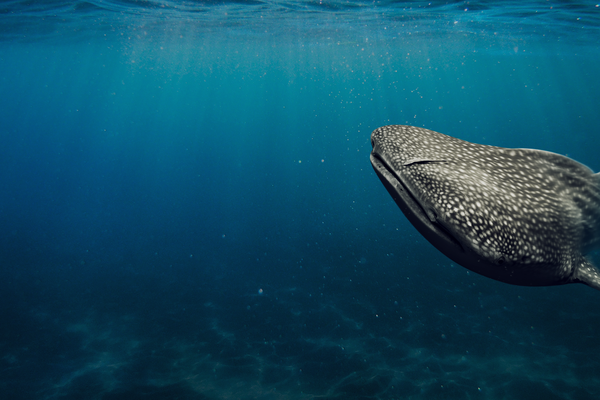Why sharks? Why now?
By learning a little about sharks, we’re better equipped to take care of Earth’s biodiversity. Sharks are among the most fascinating animals on the planet.
They were here over 400 million years ago, before dinosaurs, and have evolved to be the top predators in our oceans.

© Erik Schlögl
They have been shaped through time by their environments and have survived five mass extinctions. As ancient as they are, they bristle with senses and are as elusive as the most high-tech of modern technology. They are mysterious and awe inspiring, and have captured the imagination of humans forever. They are respected and revered by traditional knowledge holders. Shark motifs appear in countless artworks and objects throughout the world, but especially in our region; Australia and the Pacific. Sharks are kin, they are teachers and guardians. They care for and protect people and culture. In return people must care for and protect them. It’s for all of these reasons that the Australian Museum spent three years building the exhibition Sharks.
There are about 500 species of sharks and they belong to a broad family of fish that includes rays and chimeras who all have cartilage instead of bones. The difference between a shark and a ray is that the ray’s gills are on its underside, facing directly down. They differ from chimeras because the chimera has only a single gill slit on each side. Sharks themselves are very diverse with new species still being discovered. Many ancient sharks looked very different to our modern sharks. There were sharks with bizarre teeth arrangements like the Helicoprion, which puzzled scientists for decades. The biggest fish that ever lived was the Megalodon, which grew to a length of 18m.

© Australian Museum
It was a relatively recent shark living only about 20 million years ago. As the world changed, environments changed and sharks adapted. Adapting to a changing world is something sharks have been very successful at. We can tell from fossils that sharks maintained a basic body plan from very early on. This basic plan has seen sharks through the shifting of continents, the catastrophic strike of comets and the waxing and waning of ice ages. However, they may not survive humans – damaging our world is something humans have been very good at.
We have been thoughtless in our caring, we have been heartless in our loving and we have been unfaithful in our commitment to the sustainable development of our environment. Rosalie Uaniva Havea, Principal, Tongan Language School, Sydney.
A foundational block in the Jenga tower of Earth’s biodiversity
Why should we care if sharks live or die? They are an apex predator, after all – wouldn’t removing them from the ocean simply allow other species to flourish? The answer is no – and this is the heart of biodiversity. Biodiversity is the Earth’s most important and complex feature – it’s what makes Earth, Earth. It is the ancient interplay between the planet’s millions of species, from bacteria in the soil to birds on the wing, that maintains a functional physical environment.

Sharks are ecosystem engineers; they modify the ecosystems in which they live.
They are most famous for being apex predators. That’s important, but only a few species of sharks actually fill that role. Just as vital are the sharks that fill the role of mid-level predators in ecosystems. They keep different parts of the ecosystem in check by controlling the populations of their prey.
Image: Australian Museum© Australian Museum
So, where do sharks fit in? Sitting at the top of the food chain, their existence underpins entire ecosystems. Sharks prey on smaller predators. In open water, when sharks are removed, their prey overpopulate and reduce the numbers of smaller herbivorous fish, which in turn allows algae to become overgrown. In some circumstances, like a coral reef, this can cause total collapse. Meanwhile, in seagrass meadows, sharks preserve the habitats of crustaceans and small fish by controlling populations of turtles and dugongs that would overpopulate and overgraze seagrass if sharks were removed. When the seagrass is gone, the ecosystem is destroyed. Seagrass and seaweed are also major carbon absorbers – the destruction of the ocean’s flora by unchecked populations of herbivores means more greenhouse gases in the atmosphere and a fast-track to global warming. No species lives in isolation, including humans. Take out sharks and the balance of oceans falls down, as does the fishing industry, the containment of carbon in the water, the Jenga tower of life as we know it.
All the things we have in our ecosystem are there for a reason. Prof Colin Simpfendorfer, James Cook University, Queensland.
A challenge to learn more and act on what we know
The Australian Museum chose sharks as the topic of the 2022-23 blockbuster exhibition because they give us a clear example of our impact and opportunity in the natural world. As the apex predator for so many ecosystems, their removal will have dramatic consequences for life. Simply removing a top predator can turn rich areas into deserts. On the flip side, the measures needed to save sharks will help many more species and habitats. If we focus on sharks we can understand a global problem and imagine global solutions.
This project was made possible thanks to Create NSW, NSW Department of Primary Industries, Lindblad Expeditions – National Geographic, Minderoo Foundation, Macquarie University and ABC Radio Sydney.











